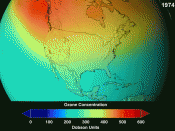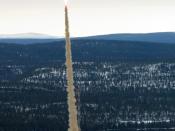When scientists wish to study the atmosphere above us, many different means of transportation are used:
Aircraft - Maximum altitude, regular aircraft: 10 km. High altitude aircraft: 25 km.
Sounding rockets - From 2-3 km to 1000 km.
Satellites - Lowest altitude possible (due to air density): about 200 km.
One of the most interesting areas of study in recent years has been the ozone layer, at an altitude of about 25 - 35 km. A problem with studies of the ozon layer is the fact that it cannot be reached by means of planes or satellites. Using sounding rockets will transport the experiment to the ozone layer without any problems, but the time of contact is very short due to the speed of the rocket. A rocket flying to these altitudes is only in the air for a couple of minutes, and the time that the rocket is at a certain altitude is very short, due to the trajectory of the rocket.
If one wishes to study a certain layer for a period of time, a stratospheric balloon is the natural solution. A balloon can stay at the same altitude for a long time, even weeks, weather permitting. Normally, a balloon from Esrange will fly for 3 - 4 hours, before the flight is terminated. This is done by releasing the payload from the balloon, letting the payload fall to the ground attached to a parachute.
Areas of science using balloons for scientific purposes are:
-ozone studies which have become a major field of science in recent years
-astronomy
-astrophysics
-micro gravity studies
By means of balloons, the scientists can send their experiments to altitudes where the atmosphere no longer interferes with their measurements.
In addition, stratospheric balloons can be used to test systems that are being launched...


